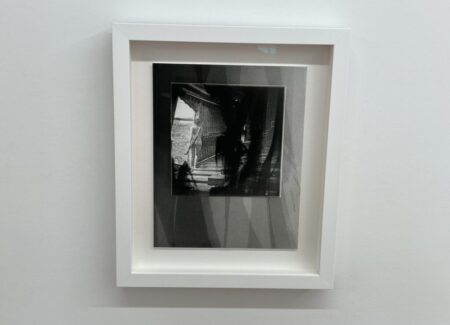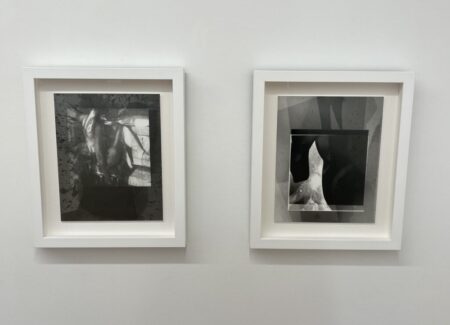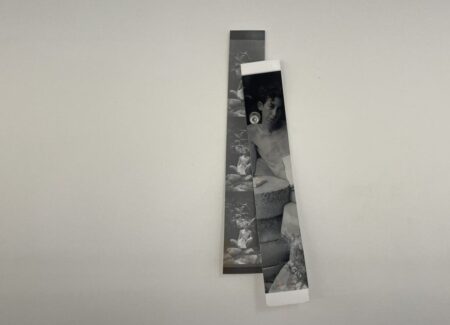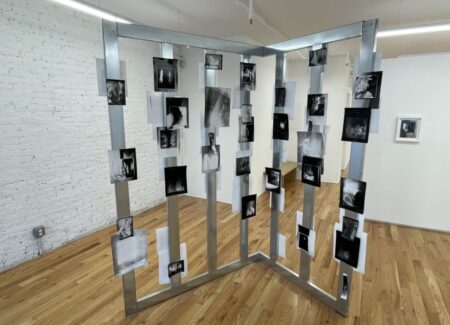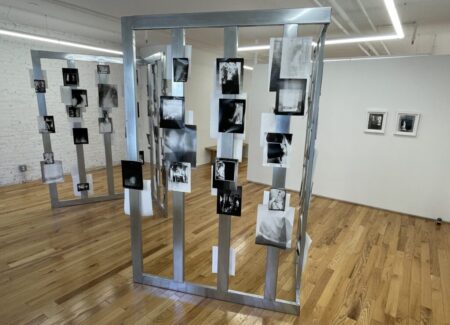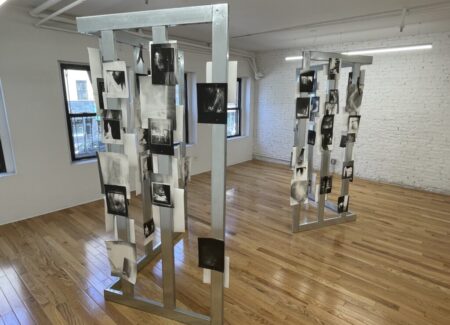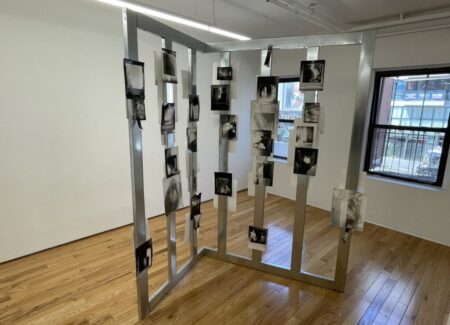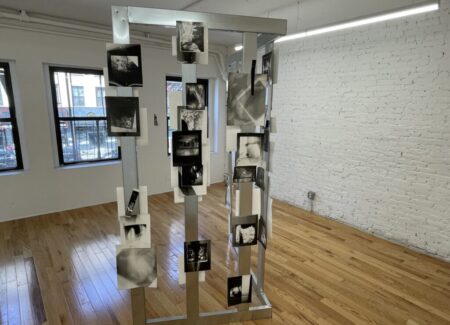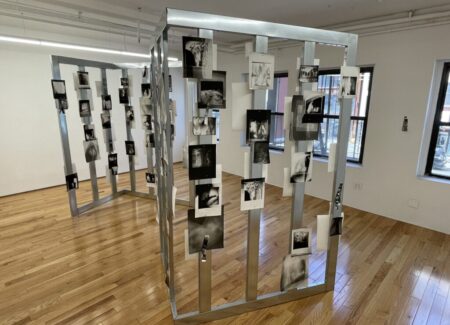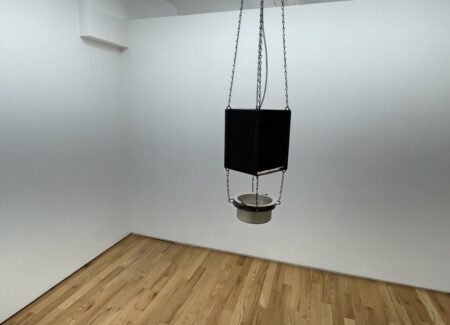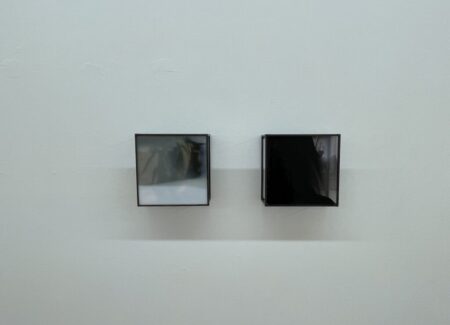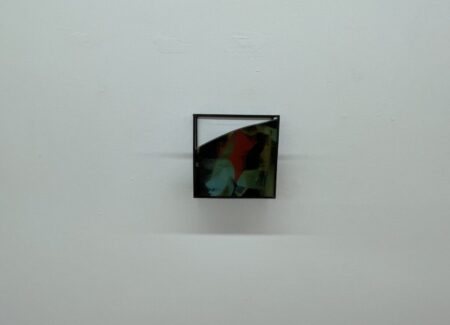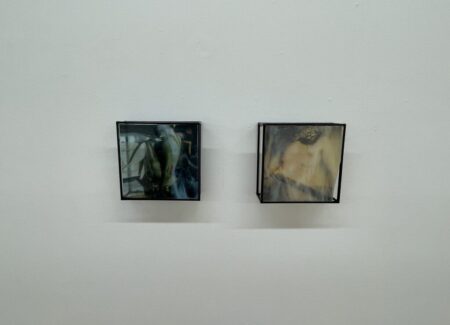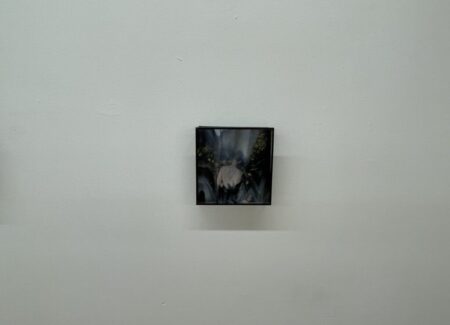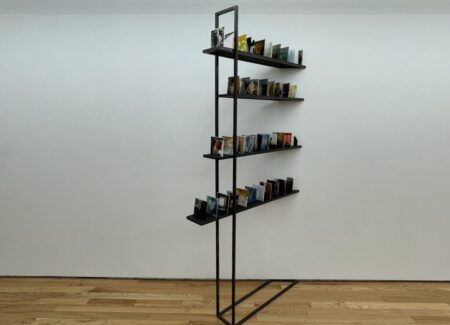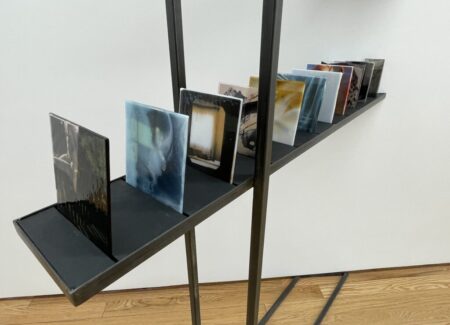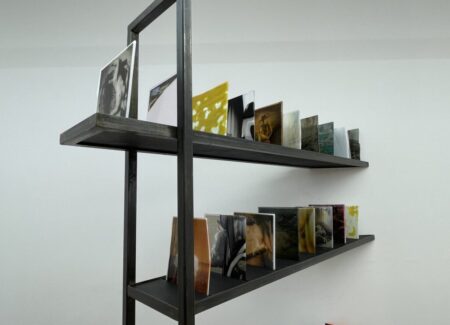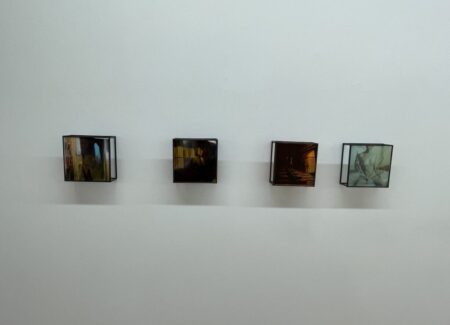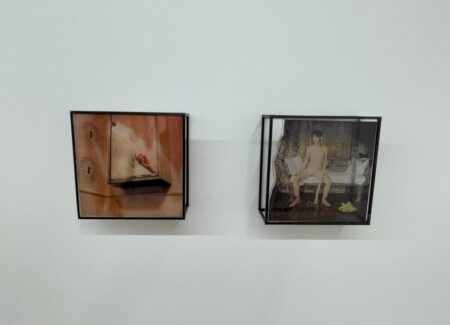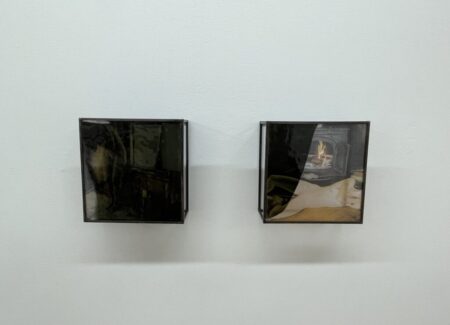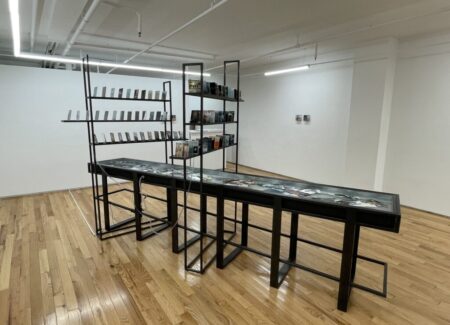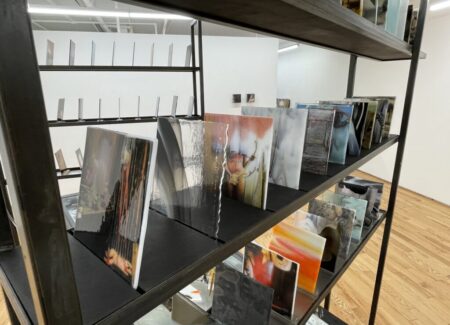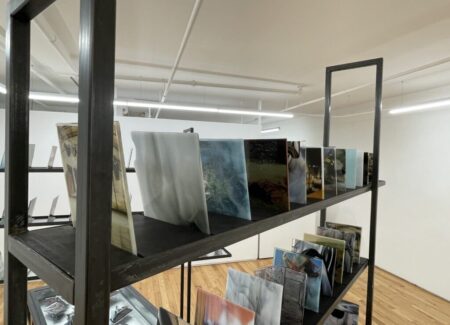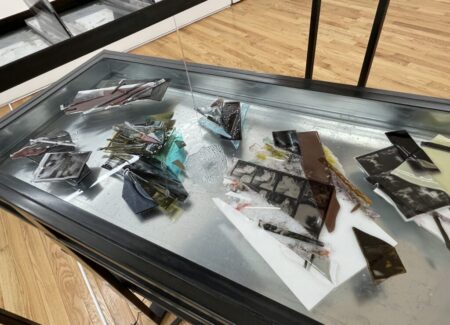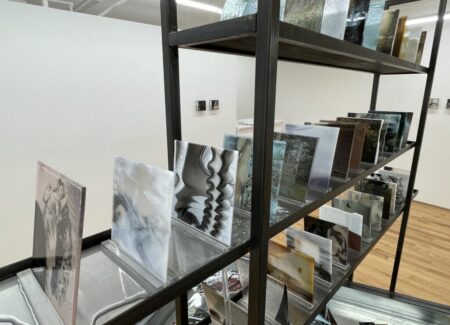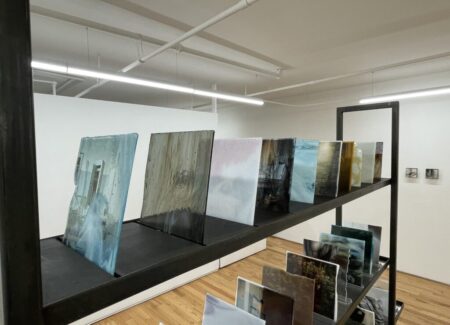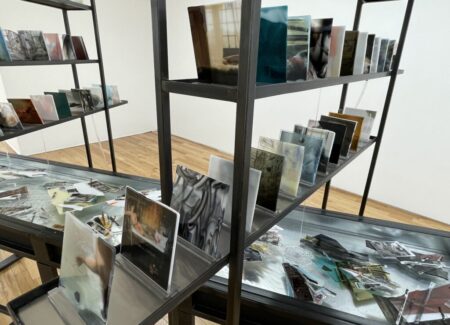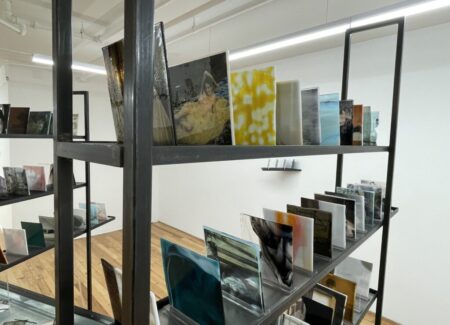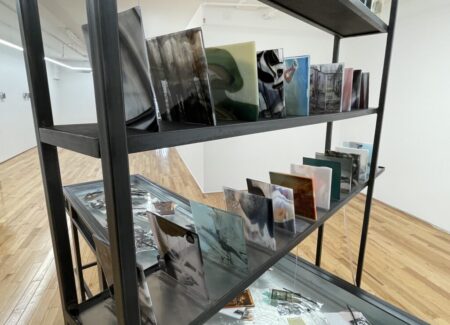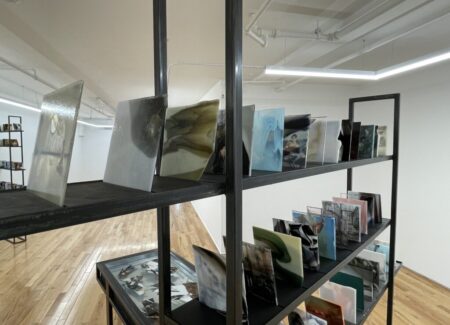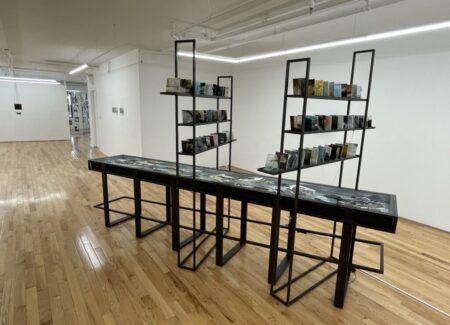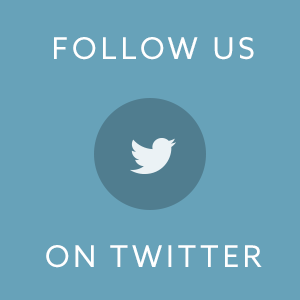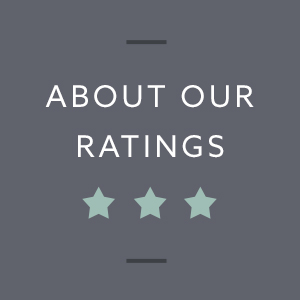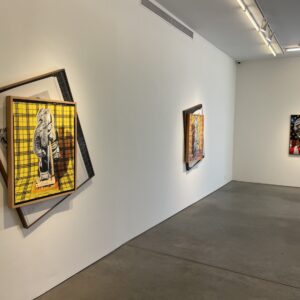JTF (just the facts): A show mixing photographic works and sculptural/photographic installations, on display in the main gallery space, the entry area, and the smaller front room. (Installation and detail shots below.)
The following works are included in the show:
- 18 self portraits on stained glass, brass armature, 2025, sized roughly 6x6x2 inches, unique
- 3 gelatin silver prints from stained glass negatives, 2025, sized 10×8 inches, unique
- 1 installation of gelatin silver prints from stained glass negatives, test strips, magnets, and galvanized steel, 2025, dimensions variable
- 1 stained glass negative, enlarger lens, chain, LED light, 2025, dimensions variable, unique
- 1 installation of stained glass negatives, steel, 2025, sized 96x8x50 inches, unique
- 1 installation of stained glass negatives, steel, 2025, sized roughly 6x18x14 inches, unique
- 1 installation of stained glass negatives in custom steel negative carriers, kiln fused glass, darkroom sink, water pump, 2025, sized 96x144x72 inches
Comments/Context: The process of revisiting old self-portrait photographs is almost by definition an exercise in recalibrating memory. We look back at earlier versions of ourselves, rediscover and reinterpret how we looked or felt, and slowly claim (or even drastically reimagine) the clues to personal history that we find there. Perhaps inevitably, there is a creeping sense of nostalgia that can get added to the mix, unless the past is filled with pain or trauma, in which case, those days long gone aren’t remembered with such innocence or fondness. And whatever the circumstances, the person captured in the pictures might not really reflect the person we are now, making the back and forth visual comparisons between past and present all the more resonant.
Rowan Renee’s current gallery show extends this process of self-examination through long term portraiture beyond the usual limits of photography as a medium. Renee’s project starts with pictures made a decade ago (in both black-and-white and in color), which have then been more recently distorted, interrupted, and reprocessed in the form of imagery embedded in kiln-fused glass. These hardened “stained glass” objects are essentially two sided, creating front and back see-through layers of interpretation, with the properties of the glass substrate (transparency, opacity, color tinting, expressive swirls, etc.) adding additional opportunities for altering our perception of the original photographs.
The images that provide the raw material for Renee’s more recent reinterpretations find the artist introspectively exploring facets of personality, particularly the dualities of masculinity/femininity of a gender queer identity. Renee is posed both partially clothed and nude (including several images in a red one piece swimsuit), on couches, in mirrors, near a wood stove, at windows and doors, wearing hats and boots, variously reclining, and carrying a rifle, an axe, or a rack of deer antlers. As seen here, this richly layered archive of personal imagery has then been actively remixed in two different ways: once through the aesthetics of expressive black-and-white darkroom photography (in the front room) and then again through the fused combination of color photography and art glass (in the main gallery space). Both approaches are further expanded by sculptural installations of different kinds, which bring the photographic images off the walls and onto three-dimensional structures and armatures.
The title of the show “My image is a lens” is an apt summary of Renee’s interior process, where the archive of self-portraits has been used as a catalyst for further self-exploration. In Renee’s black-and-white works, individual pictures become the starting point for improvisational darkroom experimentation, including picture-within-picture negative layering, photogram techniques, chemical washes, and other less identifiable interruptions, fogs, shadows, and darkenings. Many of the resulting prints have been hung unframed on a pair of steel skeletons in the center of the smaller gallery, almost as if they were drying there, or causally pinned up for review. The prints are shown in different sizes, as multi-image strips, and in repeated variations, in some cases with the same image reworked again and again, like a painful memory that needs to be replayed until it loses its sting. Seen as one installation, it’s an expressive aggregation of fragments and visual echoes, the original self-portraits broken down and diluted until they have become essences.
In the main space, Renee takes the darkroom metaphor further, with sculptural installations of an enlarger hanging from the ceiling and a long darkroom sink filled with burbling water, flanked by shelves of drying racks and negative carriers. These streamlined physical structures are then populated with Renee’s hardened glass works, which reprocess the self-portraits through a combination of darkroom approaches and glass making techniques, where splashes of chemicals and streaks of tinted glass liberally intermingle to reimagine the faces and bodies. The installation features dozens of individual glass plates, some isolated and shown on hollow steel blocks hung on the wall, with many more placed in the angled racks one after another. While it isn’t always easy to see the single works in this setup, the strongest of Renee’s glass negatives push the original imagery into a swirling zone of color and transparency, where mists of color drift across the photographic personas and memories, softening their crispness and burnishing their moments into more isolated approximations and near abstractions.
Down in the water, yet another round of works can be discovered, which combine sliced film strips and contact sheets with shards and plates of glass, as though piled up and overlapped as they drift in the water bath. In fact, they are altogether hardened and stuck together, the layered geometries and image fragments twisting and seemingly self-arranging. These works are more overtly sculptural than the single glass negatives, aggregating strips and cuttings into Constructivist-like compositions.
Conceptually, I’m interested by the way that Renee is using the object-making process of photography (particularly in the darkroom) as a representation of a deeper process of personal interrogation, or even healing. In this way, each print, or each transformed work in an adjacent artistic medium like glass, is an intermediate stop on a longer journey of investigation, the results mirroring the changes going on in the artist’s perception (or memory) of who they are (or were). In a sense, Renee is altogether rejecting the essential reproducibility of photography, and confirming that as time passes, even static images continue to evolve and change, at least in the way we see them. The layers of deliberate and chance interventions in the darkroom and the kiln ensure that Renee’s photographs are mutable, evoking the elusiveness of memory. There’s a nugget of a very intriguing idea buried in these mixed media explorations, where the properties of different artistic mediums are amalgamated to approximate something more complex than photography can typically capture on its own. It is this mystery that becomes the central subject, and the one worth wrestling with more in the future.
Collector’s POV: The works in this show are priced as follows.The stained glass negative works are $900 each on their own, or $1400 each with the metal armature. The gelatin silver prints are $2200 each. The sculptural glass/glass negative works (seen in the darkroom sink) are priced between $900 and $3000, based on size. Renee’s work has little secondary market history at this point, go gallery retail remains the best option for those collectors interested in following up.
